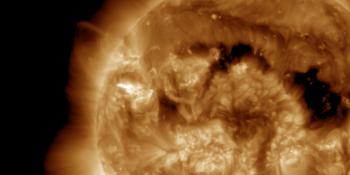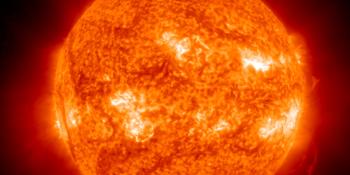Przeglądasz Archiwum z piątek, 20 czerwca 2003
Raport aktywności słonecznej
Każdy wspomniany rozbłysk słoneczny w tym raporcie ma współczynnik skalowania dodany przez Space Weather Prediction Center (SWPC). Przez skale współczynników SWPC, raporty o rozbłyskach słonecznych są o 42% mniejsze niż naukowo jakościowa data. Skale współczynników zostały usunięte z naszych archiwów o rozbłyskach słonecznych by odzwierciedlić prawdziwe jednostki fizyczne.
Raport aktywności słoneczno- geomagnetycznej 2003 Jun 20 2200 UTCPrzygotowane przez NOAA © SWPC i przetworzone przez SpaceWeatherLive.com
Połączenie raportów USAF/NOAA o słonecznej i geofizycznej aktywności
Numer SDF 171 wydany w 2200Z na 20 Jun 2003IA. Analiza aktywności regionów słonecznych i aktywność od 19-2100Z do 20-2100Z Solar activity increased to low levels today. Region
386 (S07E17) produced two low levels C-class flares today along with
several B-class flares. The northern portion of the penumbral field
appears to have undergone some rotation since yesterday while the
delta magnetic structure in the southern leading edge of group has
changed little during the period and remains intact. Region 387
(N18E36) was quiescent today although spot coverage and magnetic
complexity have both shown growth over the period. Region 389
(S12E14) was newly numbered today.
IB. Prognoza aktywności słonecznej
Solar activity is expected to range
from low to moderate levels. Region 386 remains capable of
producing an isolated major event.
IIA. Podsumowanie aktywności geofizycznej 19-2100Z do 20-2100Z
The geomagnetic field was at predominantly unsettled levels today as
effects from the western most recurrent coronal hole wanes. The
greater than 2 MeV electron flux at geosynchronous orbit reached
high levels today.
IIB. Prognoza aktywności geofizycznej
The geomagnetic field is
expected to be at predominantly unsettled levels. Active conditions
may exist especially at high latitudes beginning late on day two
with the return of a recurrent coronal hole high speed stream.
III. Prawdopodobieństwa zdarzenia 21 Jun do 23 Jun
| Klasa M | 40% | 40% | 40% |
| Klasa X | 10% | 10% | 10% |
| Proton | 10% | 10% | 10% |
| PCAF | yellow | ||
IV. Przepływ 10,7 cm z Penticton
Zaobserwowano 20 Jun 117 Przewidywane 21 Jun-23 Jun 115/115/120 Średnia z 90 dni 20 Jun 125
V. Indeks geomagnetyczny A
Zaobserwowano Afr/Ap 19 Jun 016/018 Szacowane Afr/Ap 20 Jun 010/015 Przewidywane Afr/Ap 21 Jun-23 Jun 010/015-012/015-012/020
VI. Prawdopodobieństwa aktywności geomagnetycznej 21 Jun do 23 Jun
| A. Średnie szerokości geograficzne | |||
|---|---|---|---|
| Aktywne | 15% | 25% | 25% |
| Słaba burza | 05% | 05% | 10% |
| Bardzo znacząca burza | 01% | 01% | 01% |
| B. Wysokie szerokości geograficzne | |||
|---|---|---|---|
| Aktywne | 30% | 30% | 40% |
| Słaba burza | 15% | 15% | 20% |
| Bardzo znacząca burza | 05% | 05% | 05% |
Wszystkie czasy w UTC
<< Idź do codziennego przeglądu
Najnowsze wiadomości
Najnowsze wiadomości z forum
AR 3959 14IP cameras for sky surveillance 41Comet C/2024 G3 (ATLAS) in LASCO C3 10Unspecified geomagnetic activity 1836Filaments and prominences 612
Więcej tematówWesprzyj SpaceWeatherLive.com!
Wielu ludzi odwiedza SpaceWeatherLive aby śledzić aktywność słoneczną lub sprawdzić czy jest szansa na zaobserwowanie zorzy polarnej. Niestety, większy ruch na stronie oznacza większe koszty utrzymania serwera. Dlatego, jeśli jesteś zadowolony ze strony SpaceWeatherLive, zachęcamy do wspierania nas finansowo. Dzięki temu będziemy mogli utrzymać naszą stronę.

Fakty na temat pogody kosmicznej
| Ostatnie rozbłyski klasy X | 2025/01/04 | X1.85 |
| Ostatnie rozbłyski klasy M | 2025/01/09 | M1.1 |
| Ostatnia burza geomagnetyczna | 2025/01/04 | Kp5 (G1) |
| Dni bez plam słonecznych | |
|---|---|
| Ostatni dzień bez skazy | 2022/06/08 |
| Średnia miesięczna liczba plam słonecznych | |
|---|---|
| grudnia 2024 | 154.5 +2 |
| stycznia 2025 | 140.8 -13.8 |
| Ostatnie 30 dni | 151.7 +34.3 |


